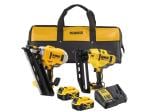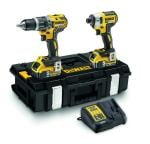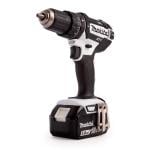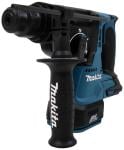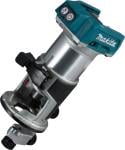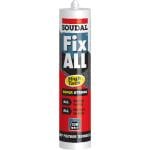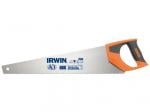Jigsaw Buying Guide
Posted on 12/01/24
An Introduction to Buying a Jigsaw
When it comes to versatile cutting tools in the world of woodworking and DIY projects, the jigsaw stands out as a key player. Known for its distinct reciprocating blade and user-friendly design, a jigsaw is an indispensable tool for anyone looking to make precise curved and straight cuts in various materials.Whether you're a seasoned professional tackling complex projects or a home enthusiast engaged in creative DIY tasks, choosing the right jigsaw can elevate your work's quality and efficiency. Jigsaws come in a myriad of styles, each with unique features tailored to different cutting needs.
From powerful corded models that deliver consistent performance to convenient cordless varieties that offer freedom of movement, the range of options can be overwhelming. This guide is designed to simplify your decision-making process, providing you with the necessary insights into the world of jigsaws.
Understanding the nuances of motor power, blade compatibility, cutting actions, and additional functionalities like variable speed settings and orbital actions is crucial. These factors, along with ergonomic design and safety features, play a significant role in determining the effectiveness of a jigsaw in your toolkit.
As we delve into this buying guide, we'll explore the key features to look for, compare different models and brands, and provide tips on maintaining your jigsaw. Our goal is to equip you with all the knowledge you need to make an informed decision, ensuring you select a jigsaw that not only meets your project requirements but also enhances your crafting experience.
The Different Types of Jigsaw
Jigsaws are versatile tools used for cutting intricate shapes and straight lines in various materials. They come in several types, each suited to specific needs and applications. Understanding these types can help you choose the right jigsaw for your project.Corded Jigsaws
- Description: These jigsaws are powered by electricity via a cord plugged into an outlet.
- Advantages: They typically offer more power and can run indefinitely, making them ideal for longer or more demanding projects.
- Best For: Continuous use and situations where consistent power is needed.
Cordless Jigsaws
- Description: Powered by rechargeable batteries, cordless jigsaws offer portability and convenience.
- Advantages: They are excellent for work where access to power outlets is limited or for ease of movement without a cord.
- Best For: Jobs that require mobility and outdoor work.
Pneumatic Jigsaws
- Description: These are air-powered jigsaws, typically used in industrial settings.
- Advantages: Pneumatic jigsaws are very powerful and durable, suitable for heavy-duty tasks.
- Best For: Professional use in workshops and industrial applications where compressed air is readily available.
Orbital Jigsaws
- Description: These jigsaws have an orbital action feature that moves the blade in a slight elliptical pattern, enhancing cutting speed.
- Advantages: They provide faster cutting, especially in softer materials like wood.
- Best For: Projects requiring quick cuts or working with softer materials.
Variable Speed Jigsaws
- Description: These jigsaws allow the user to adjust the speed of the blade.
- Advantages: Variable speed offers greater control and precision, making it easier to cut different materials effectively.
- Best For: Tasks that involve a variety of materials, requiring different cutting speeds for optimal results.
Barrel-Grip Jigsaws
- Description: The design of these jigsaws features a barrel-like grip, allowing closer hand control near the cutting line.
- Advantages: Enhanced precision and control, especially for intricate cuts.
- Best For: Detailed and precision work, or for users who prefer a lower grip close to the workpiece.
Top-Handle Jigsaws
- Description: These have a traditional handle on the top of the saw.
- Advantages: They are generally more comfortable to use for extended periods and are easier to maneuver.
- Best For: General-purpose use, suitable for a variety of projects and comfortable for most users.
Key Features to Consider When Buying a Jigsaw
When shopping for a jigsaw, several important features can significantly impact the tool's performance, usability, and suitability for your projects. Here's what to look for:Motor Power
- Importance: Determines the jigsaw's cutting ability. Higher power (measured in watts for corded and volts for cordless models) means more robust performance.
- Consideration: Choose higher power for tough materials and professional use; moderate power is sufficient for general DIY tasks.
Blade Type
- T-Shank vs U-Shank: T-shank blades are generally easier to change and more widely used, while U-shank blades may require tools for changing.
- Consideration: Ensure the jigsaw supports the blade type you prefer or offers compatibility with both.
Orbital Action
- Function: Allows the blade to move in a slight circular motion, enhancing cutting efficiency, especially in wood.
- Consideration: Useful for aggressive, faster cutting. Some jigsaws allow you to adjust the level of orbital action.
Variable Speed
- Importance: Different materials require different cutting speeds for optimal results.
- Consideration: Look for a jigsaw with a variable speed dial or trigger for better control.
Bevel Cutting Capability
- Function: Allows the base of the jigsaw to tilt for making angled cuts, typically up to 45 degrees.
- Consideration: Essential for projects that require bevel cuts. Check the ease of adjusting the bevel settings.
Corded vs. Cordless
- Corded: Offers consistent power, ideal for longer or more demanding tasks.
- Cordless: Provides portability and ease of use, best for quick tasks and varied locations.
- Consideration: Decide based on your primary work environment and accessibility to power outlets.
Ergonomics and Comfort
- Importance: Comfortable handling can reduce fatigue and increase precision.
- Consideration: Look for a comfortable grip, low vibration, and a lightweight design if prolonged use is anticipated.
Dust Blower and Extraction
- Function: Keeps the cutting line clear of debris for better visibility.
- Consideration: Especially useful for intricate cuts or when clean lines are essential.
Safety Features
- Examples: Blade guards, lock-on switches, and anti-splintering devices.
- Consideration: Essential for safe operation. Evaluate the effectiveness and ease of use of these features.
LED Light
- Function: Illuminates the cutting area for better visibility.
- Consideration: Beneficial in low-light conditions or for detailed work.
Jigsaws: Ergonomics and Ease of Use
When selecting a jigsaw, ergonomics and ease of use are crucial factors that significantly impact user comfort and the overall quality of work. A well-designed jigsaw can make a substantial difference, especially during extended periods of use or complex projects. Here's what to consider:Handle Design
- Types: Jigsaws typically come with either a top handle (D-handle) or a barrel grip.
- Top Handle: Offers a comfortable grip and is generally preferred for general-purpose use. It allows easy maneuverability and is user-friendly for beginners.
- Barrel Grip: Provides closer control and is favored for precision cutting. It may take some time to get used to but offers excellent stability and control, especially for intricate work.
- Consideration: Choose based on personal comfort, control preference, and the type of projects you undertake.
Vibration Control
- Importance: Excessive vibration can lead to fatigue and less precise cuts.
- Features: Look for models with counterbalance mechanisms or vibration-reducing technologies.
- Consideration: Lower vibration is particularly important for intricate work and when using the saw for extended periods.
Weight and Balance
- Weight: A lighter jigsaw is easier to handle, especially for overhead work or when maneuvering complex cuts.
- Balance: A well-balanced tool reduces strain on your hand and wrist, contributing to better control and precision.
- Consideration: Test the feel of the jigsaw in your hand if possible. Balance can be more important than just weight alone.
Blade Change System
- Types: Tool-less blade change systems are common in modern jigsaws.
- Advantages: Allows for quick and easy blade changes without the need for additional tools, enhancing convenience and efficiency.
- Consideration: Ensure the mechanism is robust and secure, as a poorly designed system can affect the cutting accuracy and blade stability.
Onboard Controls and Adjustments
- Features: Speed dials, orbital action controls, and bevel adjustments located on the tool for easy access.
- Benefits: Enhances usability and allows for quick adjustments during work.
- Consideration: Look for intuitive and easily accessible controls that do not interrupt the workflow.
Dust Management
- Dust Blower and Extraction: Keeps the cutting line clear, improving visibility and accuracy.
- Consideration: Effective dust management is important for maintaining a clean work area and clear line of sight on the cut.
Jigsaws: Safety Features
Safety is a paramount consideration when working with any power tool, and jigsaws are no exception. Understanding and evaluating the safety features of a jigsaw is crucial to ensure secure operation and to prevent accidents. Here are key safety features to consider when selecting a jigsaw:Blade Guard
- Function: Protects the user from accidental contact with the moving blade.
- Importance: A blade guard is essential for reducing the risk of injury, especially when the tool is not in use or in the event of a slip.
Lock-On Switch
- Function: Allows the saw to continue running without continuous finger pressure on the trigger.
- Importance: Useful for extended use, reducing fatigue. However, it should be used with caution and always turned off when the saw is not actively being used.
Variable Speed Trigger with Lock-Off
- Function: A trigger that requires deliberate action to activate the saw, preventing accidental start-ups.
- Importance: Increases safety by ensuring the saw only operates when intentionally engaged by the user.
Non-Slip Grip
- Function: Rubberized or textured handles that provide a secure grip, even with sweaty hands or gloves.
- Importance: A secure grip is crucial for maintaining control of the saw, particularly during intricate cuts or when maneuvering the tool.
Anti-Splintering Device
- Function: Minimizes splintering of the material being cut, which can create sharp fragments.
- Importance: While primarily a feature for cut quality, it also contributes to safety by reducing debris that could cause injury.
Dust Extraction
- Function: Connects to a vacuum system to remove dust and debris from the cutting area.
- Importance: Keeps the workspace clean and improves visibility, reducing the risk of accidents caused by obscured lines of sight.
Emergency Stop
- Function: A feature that allows for immediate stopping of the blade in case of an emergency.
- Importance: Enhances user safety by providing a quick way to cease operation if something goes wrong.
Jigsaws: Additional Considerations
While key features like power, blade type, and safety are crucial in selecting a jigsaw, there are other considerations that can significantly influence your choice and overall satisfaction with the tool. Here are some additional factors to keep in mind:LED Work Light
- Importance: An LED light illuminates the cutting area, enhancing visibility, especially in low-light conditions or when working with intricate patterns.
- Consideration: If you often work in dimly lit environments or require precision in detailed projects, an integrated LED light can be a valuable feature.
Onboard Storage for Blades
- Utility: Some jigsaws come with storage compartments for holding extra blades.
- Consideration: Convenient for quick blade changes and keeping your essential tools organized, especially when working in various locations.
Dust Blower vs. Dust Extraction
- Dust Blower: Clears away debris from the cut line for better visibility.
- Dust Extraction: Connects to a vacuum system for a cleaner workspace and is more effective in managing sawdust.
- Consideration: Evaluate your working conditions and preferences for cleanliness. Dust extraction is particularly beneficial for indoor work or when dealing with materials that produce fine dust.
Brand Reputation and Warranty
- Reputation: Established brands often offer higher quality and more reliable customer service.
- Warranty: Check the warranty period and what it covers. A longer warranty can provide peace of mind and protection for your investment.
- Consideration: Consider the brand's reputation for quality and service, as well as the warranty offered, especially for higher-end models.
User Reviews and Feedback
- Utility: User reviews can provide real-world insights into a tool’s performance and durability.
- Consideration: Look for consistent patterns in reviews, such as comments on the tool’s build quality, performance, and any common issues.
Ergonomic Factors
- Factors: Weight, balance, grip comfort, and vibration reduction.
- Consideration: If possible, test the feel of the jigsaw in your hand. Comfort and ease of use are crucial, especially for prolonged or frequent use.
Compatibility with Guide Rails
- Function: Guide rails ensure straight cuts and are especially useful for long or precise linear cuts.
- Consideration: Not all jigsaws are compatible with guide rails. If straight cuts are a priority, look for models that can be used with guide rails.
Jigsaws: Overview of Brands and Models
Jigsaws are offered by several reputable brands, each bringing its unique strengths to the table. Below is an overview of some of the leading brands and their standout jigsaw models, catering to various needs and preferences.Bosch
- Reputation: Known for precision engineering and innovative technology.
- Notable Models:
- Bosch JS470E: A robust corded model known for its power and durability, excellent for heavy-duty tasks.
- Bosch JSH180B: A lightweight, cordless option from their 18V lineup, offering convenience and ease of use for less intensive tasks.
DeWalt
- Reputation: Favored for their high-quality construction and reliability.
- Notable Models:
- DeWalt DCS331B: Part of their 20V MAX system, this cordless jigsaw is known for its performance and versatility.
- DeWalt DW317K: A corded, compact model, ideal for precise cuts and varied applications.
Makita
- Reputation: Offers a blend of ergonomic design and efficiency.
- Notable Models:
- Makita XVJ03Z: A cordless model that balances power with ease of use, part of their LXT lineup.
- Makita 4329K: An affordable corded option that does not compromise on quality, suitable for both DIY enthusiasts and professionals.
Black+Decker
- Reputation: Known for providing affordable yet reliable tools.
- Notable Models:
- Black+Decker BDEJS600C: An excellent budget-friendly option with Smart Select technology for optimal settings on various materials.
- Black+Decker BDCJS20C: A cordless model from their 20V MAX series, offering good performance for light to medium tasks.
Milwaukee
- Reputation: Renowned for producing durable and powerful tools.
- Notable Models:
- Milwaukee M18 FUEL 2737B-20: A high-end cordless model known for its brushless motor and superior cutting performance.
- Milwaukee 6268-21: A corded model that stands out for its precision and robustness in demanding applications.
Festool
- Reputation: Premium brand known for top-tier quality and innovative features.
- Notable Models:
- Festool Carvex PS 420 EBQ: Offers unmatched precision and control, ideal for professional-grade detailed work.
Jigsaws: Price Range
When purchasing a jigsaw in the UK, it's essential to understand the range of prices and what features you can expect at each level. The market offers a wide spectrum of options, suitable for both budget-conscious buyers and professionals seeking high-end tools.Entry-Level Jigsaws (£20 to £50)
- Characteristics: These are basic models, generally less powerful and with fewer features. Suitable for light, infrequent tasks or simple DIY projects.
- Expectations: Basic models might lack advanced features like variable speed or orbital action but are usually sufficient for straightforward cutting tasks in softer materials.
Mid-Range Jigsaws (£50 to £100)
- Characteristics: Mid-range jigsaws offer a good balance between cost and functionality. They typically come with more power, better build quality, and additional features like variable speed and orbital action.
- Expectations: Ideal for regular DIYers or semi-professionals. These models can handle more demanding tasks and offer greater durability and precision.
High-End Jigsaws (£100 to £200 and above)
- Characteristics: High-end models are designed for heavy-duty use and often include premium features like brushless motors, superior vibration control, and advanced safety features.
- Expectations: Best for professionals and those requiring a tool for intensive use. These jigsaws offer enhanced performance, durability, and often better ergonomics.
Specialty Jigsaws (£200 and above)
- Characteristics: Specialty jigsaws, including those from premium brands like Festool, can exceed £200. These are often designed for specific, demanding applications and might include unique features like superior dust extraction, guide rail compatibility, and exceptional precision.
- Expectations: Suited for specialized professional use, where precision and tool performance are critical.
Jigsaws: Maintenance and Care Tips
Proper maintenance and care are essential for ensuring your jigsaw remains in good working condition and extends its lifespan. Regular upkeep not only improves the tool's performance but also ensures safety during use. Here are some key tips for maintaining and caring for your jigsaw:Regular Blade Checks and Replacement
- Inspection: Frequently inspect the blade for signs of wear, dullness, or damage. A sharp blade is crucial for efficient and precise cutting.
- Replacement: Replace blades as soon as they show significant wear. Using the correct blade type for different materials also helps in maintaining good cutting performance.
Keeping the Jigsaw Clean
- After Use: Clean any dust or debris from the jigsaw, especially around the blade and the vent areas. Accumulated sawdust can affect the jigsaw’s performance and may pose a fire hazard.
- Cleaning Method: Use a soft brush or compressed air to remove debris. Avoid using water or wet cloths, as moisture can damage the motor and electrical components.
- Moving Parts: Regularly lubricate moving parts, such as the blade mechanism and any pivot points, to ensure smooth operation. Use appropriate lubricants as recommended by the manufacturer.
- Avoid Over-lubrication: Excessive lubricant can attract dust and debris, leading to build-up and affecting performance.
Checking the Cord and Battery
- Corded Models: Inspect the power cord for any damage or wear. A damaged cord can be a safety hazard.
- Cordless Models: Properly maintain batteries by following the manufacturer’s charging guidelines. Store batteries in a cool, dry place and avoid overcharging.
Secure Storage
- Storage Location: Store the jigsaw in a dry, dust-free environment to prevent rust and corrosion. Use a protective case or a designated storage spot in your workshop.
- Blade Protection: Remove the blade or ensure it is well-protected during storage to prevent accidents.
Periodic Checks for Wear and Tear
- Regular Inspection: Periodically check the entire tool for any signs of wear or damage. Pay attention to the condition of the base plate, the blade clamp, and the switches.
- Professional Servicing: For any complex issues or periodic servicing, consider taking your jigsaw to a professional for maintenance.
Jigsaws: A Glossary of Terms
Bevel Cut- A cut made at an angle other than 90 degrees to the face of the workpiece. Most jigsaws allow bevel cuts at various angles, typically up to 45 degrees.
- A setting on some jigsaws that moves the blade in a slight elliptical pattern. This motion increases cutting speed and is particularly effective in wood.
- The distance the jigsaw blade travels up and down during operation. Longer stroke lengths can lead to faster cutting but might reduce accuracy.
- A type of blade that slots into the jigsaw's clamp without the need for additional tools. T-Shank blades are becoming increasingly popular due to their ease of change.
- An older style of blade that typically requires a tool, like a screwdriver, to change. It is less common in newer jigsaw models.
- Allows the user to adjust the speed of the blade. Slower speeds are used for precision and cutting metal or ceramics, while faster speeds are suitable for cutting wood.
- A feature that uses air to clear away dust from the cutting line, enhancing visibility and accuracy.
- A small, often plastic, insert that sits near the blade to reduce splintering on the upper side of the workpiece, particularly in wood.
- An integrated light that illuminates the cutting area. It is especially useful in low-light conditions or for intricate work.
- An accessory used to ensure straight cuts. Some jigsaws can be fitted with or attached to guide rails for increased accuracy.
- A mechanism that allows for easy and fast blade changes, usually without the need for additional tools.
- A jigsaw powered by a rechargeable battery, offering portability and convenience at the cost of limited run-time and sometimes power.
- A jigsaw that operates when plugged into an electrical outlet, offering consistent power and longer use without the limitations of a battery.
Jigsaw FAQs
Q: What materials can a jigsaw cut?A: Jigsaws can cut a variety of materials including wood, metal, plastic, ceramic tiles, and even countertops, depending on the type of blade used.
Q: Can a jigsaw make straight cuts?
A: Yes, although primarily used for curved cuts, with a steady hand or a guide rail, a jigsaw can also make straight cuts.
Q: What is the difference between a T-shank and a U-shank jigsaw blade?
A: T-shank blades are tool-less and quick to change, while U-shank blades often require a screwdriver or other tool for changing. T-shank blades are more widely used in modern jigsaws.
Q: Is a corded or cordless jigsaw better?
A: It depends on your needs. Corded jigsaws offer continuous power, while cordless jigsaws provide portability and convenience.
Q: How do I choose the right jigsaw blade?
A: Select a blade based on the material you are cutting. Use finer teeth for metals and plastics and coarser teeth for wood. The blade material also matters (e.g., bi-metal, carbide, high-speed steel).
Q: What is orbital action in a jigsaw?
A: Orbital action moves the blade in a slight up-and-down and forward motion, allowing faster cutting, especially in wood.
Q: Can a jigsaw cut in a bevel?
A: Yes, many jigsaws have a base plate that adjusts to make bevel cuts, typically up to 45 degrees.
Q: How do I prevent splintering when cutting with a jigsaw?
A: Use a sharp blade, appropriate for the material. Anti-splinter inserts and applying tape over the cutting line can also help.
Q: What safety precautions should I take when using a jigsaw?
A: Always wear safety goggles, keep the work area clean, ensure the material is securely clamped, and be cautious with the moving blade. Also, disconnect the jigsaw from power when changing blades.
Q: How do I maintain my jigsaw?
A: Keep it clean from debris, regularly check for and replace worn blades, ensure all moving parts are properly lubricated, and store it in a dry place.


